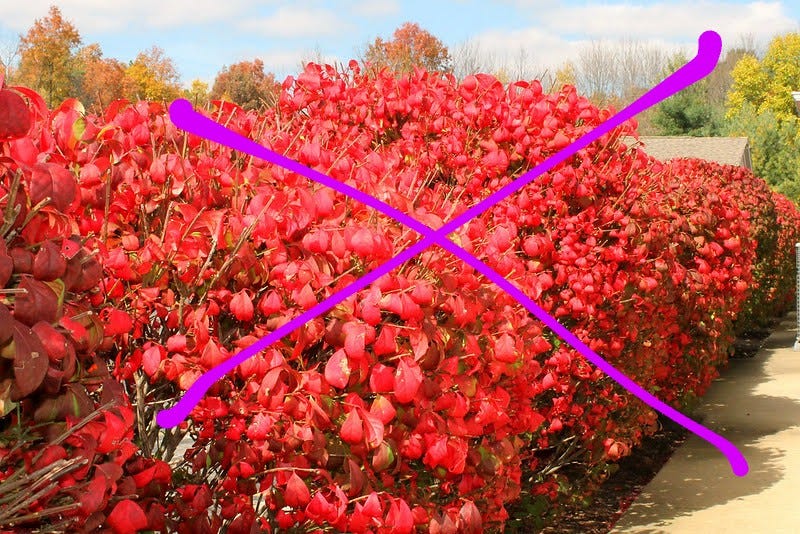Fall is a great time – the best time, actually – for planting shrubs. The soil stays more consistently moist as the temps drop. Many plants are heading into dormancy, so they require less water, anyway. The cooler air and still-warm soil stimulate root growth, meaning shrubs planted now will have put down a healthy foundation by the time spring rolls around. Also, for most of us, it’s just more comfortable to be outside when it’s not, you know…a thousand degrees in the shade. So get out there and shrub it up!
One big caveat, though. As you hunt for autumn-hued bushes to match your pumpkin-spice vibe, don’t get seduced by invasives. Mainstream nurseries are full of those scoundrels. To give you an idea, check out this petition calling on Home Depot to stop selling 23+ invasives. Twenty. Three. Each with a rap sheet that’s perfectly well known in the horticultural business. (While we’re on the topic, go ahead and sign the petition.)
Maybe big box stores and garden centers will grow environmental consciences one of these days. Meanwhile, the responsibility falls to us, as consumers, to understand a) what we’re buying and b) the impact our purchases will have on our ecosystems. Our choices matter.
Invasive: Heavenly Bamboo (Nandina domestica)
Heavenly bamboo is native to China, Japan and India. It’s been planted widely as an ornamental shrub here in the States, where it frequently escapes into the wild. It’s now invading forests throughout the southeastern U.S. It bears bright red berries that attract birds like magnets. Unfortunately, the fruits contain cyanide and are toxic to cats, dogs and the birds who gorge on them. In Georgia, Texas and elsewhere, there have been documented cases of cedar waxwings dying of cyanide poison from heavenly bamboo berries. Seven states list the shrub as invasive, yet if you take a drive through neighborhoods in those places, it’s so ubiquitous you’d almost think the local ordinances require it.

Native Alternatives: common winterberry (Ilex verticillata) or red chokeberry (Aronia arbutifolia)
Even though it’s a holly, winterberry loses its leaves in the winter. And that’s ok by me, because what you get instead is exuberant clusters of bright red berries that remain on the branches all winter. These are popular with (and non-toxic to) eastern bluebirds, hermit thrushes, wood thrushes, American robins, catbirds, northern mockingbirds, brown thrashers, cedar waxwings, and white-tailed sparrows, among others. It’s native to most of the eastern half of the U.S.

Red chokeberries are a multi-stemmed shrub. White flowers in spring and glossy green leaves in summer give way in the fall to orange-red foliage and bright red, pear-shaped (non-toxic) berries that birds eat. They’re native to the eastern U.S.

Invasive: Winged Burning Bush (Euonymous alatus)
Winged burning bush is native to northeastern Asia. It is widely sold in the U.S. for its hardiness, winged stems and intense red fall foliage. It gets planted along roadways, on commercial and industrial sites, as well as in parks and residential landscapes. It threatens forests, coastal scrublands and prairies where it forms dense thickets, displacing many native woody and herbaceous plant species. Hundreds of seedlings are often found below the parent plant in what is termed a “seed shadow.” It’s listed as invasive in 18 eastern and midwestern states.

Native Alternatives: Virginia sweetspire (Itea virginica), American cranberry bush (Viburnum opulus)
Sweetspire grows in sun or shade. It sports tassels of white flowers in the spring and red to purple foliage in the fall. It’s attractive to birds and insects and is native to the mid-Atlantic and south.


American cranberry bush has maple-like, deciduous leaves. White, flat-topped flowers are followed by persistent red berries. The berries make an excellent winter survival food for wildlife, because they remain above the snow and are sweeter after freezing. It’s native in much of the northern U.S. It’s a larval host and attracts birds and butterflies.
Thus armed, may you shred your shrub shopping. Happy sweatah weathah!
(West Coasters: hang tight. I’ll tackle some of your invasives and native alternatives soon!)
Resources
Jill Swearingen, et. al., Plant Invaders of Mid-Atlantic Natural Areas, 4th edition, National Park Service and U.S. Fish and Wildlife Service, 2010.
“Fall Is a Great Time for Planting in Your Landscape,” Penn State Extension Master Gardener Program, 2015.
Invasive Plant Atlas of the United States, University of Georgia and National Park Service.
“Plant This, Not That,” Direct Native Plants.




Excellent tips. Thanks, Lolly!